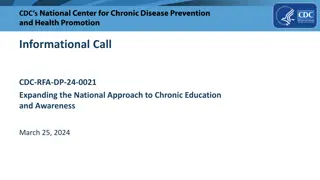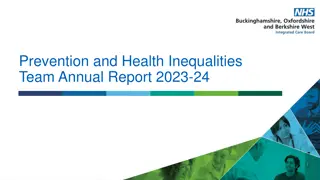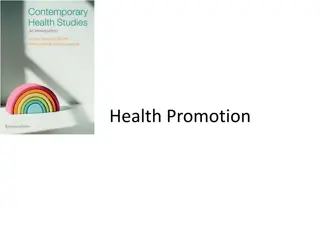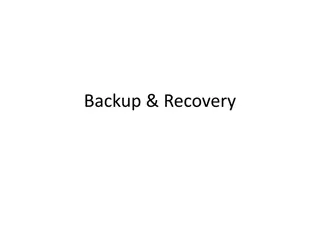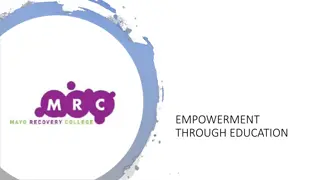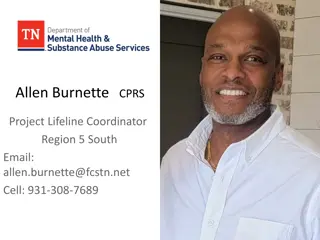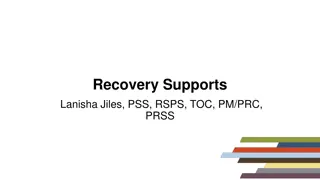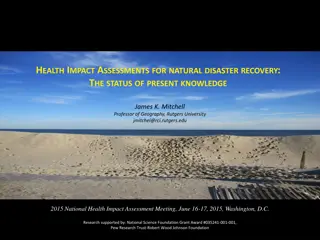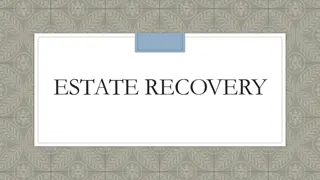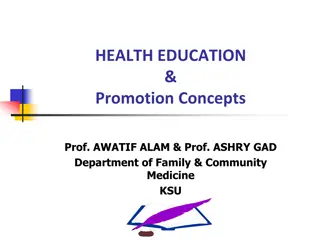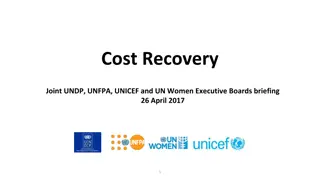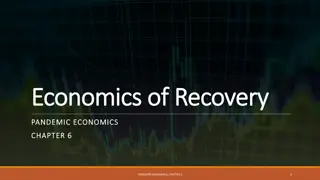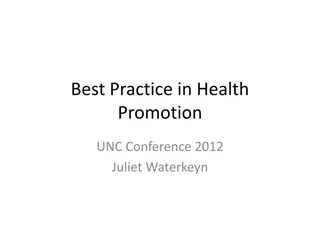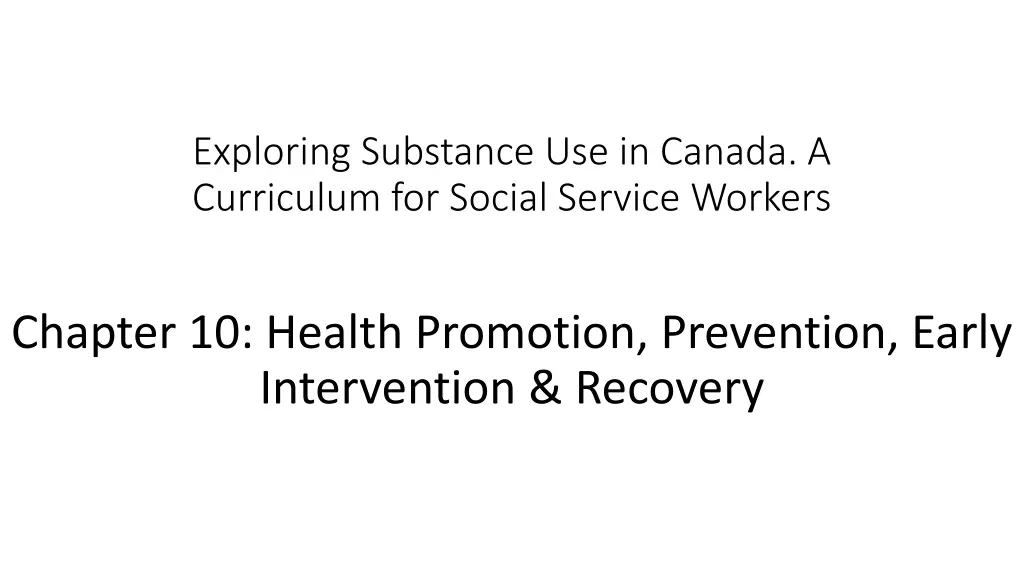
Health Promotion and Substance Use in Canada
Explore the role of health promotion in addressing substance use disorders, prevention initiatives, early intervention, and recovery in Canada. Learn about the continuum of care, models of recovery, and measures to support individuals in their recovery journey. Discover how health promotion can benefit communities impacted by substance use through addressing social determinants of health and policy development.
Download Presentation

Please find below an Image/Link to download the presentation.
The content on the website is provided AS IS for your information and personal use only. It may not be sold, licensed, or shared on other websites without obtaining consent from the author. If you encounter any issues during the download, it is possible that the publisher has removed the file from their server.
You are allowed to download the files provided on this website for personal or commercial use, subject to the condition that they are used lawfully. All files are the property of their respective owners.
The content on the website is provided AS IS for your information and personal use only. It may not be sold, licensed, or shared on other websites without obtaining consent from the author.
E N D
Presentation Transcript
Exploring Substance Use in Canada. A Curriculum for Social Service Workers Chapter 10: Health Promotion, Prevention, Early Intervention & Recovery
1.Describe the continuum of care 2.Understand and describe health promotion 3.Identify the role of health promotion in relation to substance use disorders 4.Describe the importance of prevention initiatives Learning Objectives: 5.Describe recovery 6.Describe models of recovery for clients 7.List measures that may help support an individual in recovery
The four pillars In Nova Scotia, health and wellness services that focus on substance use are provided in one of the four areas: "health promotion, addiction [substance use] prevention, early intervention, and treatment" (Government of Nova Scotia, 2021, para. 1). We explored treatment in Chapter 8, we will explore these new themes as well as recovery by breaking down each one of these concepts.
How can we use health promotion for people/communities impacted by substance use?
Health Promotion Health promotion addresses health inequities by looking at the social determinants of health and the impact of policy development that shapes health (Rootman et al,. 2018). "Health promotion in the substance use field works at a broader level than substance use prevention, with the aim of strengthening health, well-being and resiliency, reducing stigma, and addressing the root causes of harmful behaviours" (Canadian Centre of Substance Use and Addiction, 2014, p. 1). This could be through affordable housing initiatives, playground development, school-based nutrition programs and more. Health promotion benefits individuals as well as communities and can be a strategy for supporting both people who use substances and people with a substance use disorder.
https://www.youtube.com/watch?v=G2quVLcJVBk (Let's Learn Public Health, 2017).
Substance Use Prevention and Early Intervention Prevention activities are meant to prevent substance use or a behavioural issue from occurring. Early intervention focuses on programming that target specific groups of individuals once they have begun using, before use becomes a substance use disorder. Recognized as an important pillar of the continuum of health, "part of Health Canada's role is to increase awareness among youth of the dangers of experimenting with illicit drugs, and to assist parents in keeping their kids drug-free" (Government of Canada, 2016, para. 2).
Prevention Programs There are many prevention programs that focus on preventing substance use and substance use disorders. Some programs focus on substance specific prevention like alcohol, cannabis, and opioids. Other programs aim to prevent specific types of use, for example inhalation versus injection use. Some programs are specific for vulnerable groups based on age, gender, and ethnicity, as well as factors like mental health, while others focus on community and society. There are a variety of factors, both risk and protective elements, which exist within each of these contexts. For programs to be effective, as we have discussed in previous chapters, they must look beyond the substance use to the intersections with health. Researchers suggest a mix of prevention interventions is required to address substance use disorders in communities and societies.
Substance Use and Youth The early use of substances increases a person's chances of developing a disorder as substance use often begins in adolescence (Schulte & Hser, 2014). Young people aged 15 to 24 are more likely to experience mental illness and/or substance use disorders than any other age group (Statistics Canada, 2015). The risk of substance use increases greatly during times of transition. For a youth, developmental stages may result in higher risk-taking behaviour (Schulte & Hser, 2014). A certain amount of risk-taking is a normal part of adolescent development; the desire to try new things and become more independent is healthy but it may also increase the risk of experimentation. The parts of the brain that control judgment and decision-making do not fully develop until people are in their early or mid-20s (Winters & Arria, 2011).
Prevention for Youth Preventing early use of substances may reduce the number of people who develop a substance use disorder, and it may also reduce early mortality. Data from Public Safety Canada (2018) found that childhood physical abuse is a strong predictor of substance use and those who are abused are more likely to develop a substance use disorder. Researchers, community advocates, and agencies have developed numerous interventions to address risk and protective factors for substance use. Each program may or may not work depending on the audience, the location, and the strategy.
Early Intervention As information about substance use and substance abuse disorders grows, so have intervention strategies. The "Just Say No" Campaign and other programs focusing on how to refuse substances failed to address the determinants of health and their connection to substance use and abuse. Programs today focus on not only helping individuals develop the knowledge, attitudes, and skills they need to make good choices but address the larger systemic issues that impact their ability to understand the choices they make. For example, the Canadian Drugs and Substances Strategy includes prevention, treatment, harm reduction, evidence and enforcement, as well as funding for these initiatives (Government of Canada, 2019).
Can people who live with a substance abuse disorder recover? Approximately 21% of the population in Canada (about 6 million people) will meet the criteria for a substance use disorder in their lifetime (Statistics Canada, 2015).
What is recovery? Recovery is more than simply stopping uncontrolled substance use, but rather is often defined as improvements in health, wellbeing, and social participation, or living a productive life" (McQuaid et al., 2018). Substance abuse disorders are treatable disorders. Research on the science of addiction and the treatment of substance use disorders has led to the development of research-based methods that help people to stop using substances, also known as being in recovery. Recovery, however, is not a cure. What is recovery Like other chronic diseases such as heart disease or asthma, treatment for substance use disorder is just that, treatment. Treatment enables people to manage/mitigate the substance abuse disorder's impacts on their brain, body, and behavior.
https://www.youtube.com/watch?v=CHsZ-KSHbcE&feature=emb_logohttps://www.youtube.com/watch?v=CHsZ-KSHbcE&feature=emb_logo (Canadian Centre on Substance Use and Addiction, 2017b).
It can be paved with lapses and relapses, there may be many starts and stops. It is very important that all attempts at recovery be supported. Individuals should have the opportunity to feel hope rather than shame and criticism. Recovery is a bumpy road.
Self Care Please complete the self care activities in chapter 10, and report back next class.
References Canadian Centre on Substance Use and Addiction. (2017). Life in recovery from addiction in Canada: A technical report. https://www.ccsa.ca/sites/default/files/2019- 04/CCSA-Life-in-Recovery-from-Addiction-Report-2017-en.pdf Canadian Centre on Substance Use and Addiction. (2017b). Changing the stigmatizing language of addiction to support recovery. [Video]. Youtube. https://www.youtube.com/watch?v=CHsZ-KSHbcE Canadian Centre on Substance Use and Addiction. (2014). Substance use prevention and health promotion. https://www.ccsa.ca/substance-use-prevention-and-health- promotion-essentials-series Government of Canada. (2016) Drug prevention. https://www.canada.ca/en/health-canada/services/health-concerns/drug-prevention-treatment.html Government of Canada. (2019). Canadian drugs and substances strategy. https://www.canada.ca/en/health-canada/services/substance-use/canadian-drugs-substances- strategy.html?utm_source=vanity_url&utm_medium=url_en&utm_content=redirect_justice_nationalantidrugstrategy.gc.ca&utm_campaign=pidu_14/index.html Government of Nova Scotia. (2021). Health and wellness initiatives, programs, and services. https://novascotia.ca/dhw/programs-and-services.asp Let's Learn Public Health. (2017). An introduction to health promotion and the Ottawa charter. https://www.youtube.com/watch?v=G2quVLcJVBk McQuaid, R. J., Jesseman, R., & Rush, B. (2018). Examining barriers as risk factors for relapse: A focus on the Canadian treatment and recovery system of care. The Canadian Journal of Addiction, 9(3), 5 12. https://doi.org/10.1097/CXA.0000000000000022 Pan American Health Organization. (2002). Public health in the Americas. Technical publication no. 589. Pan American Health Organization. Public Safety Canada. (2018). School-based drug abuse prevention: Promising and successful programs. https://www.publicsafety.gc.ca/cnt/rsrcs/pblctns/sclbsd- drgbs/index-en.aspx#ftn34) Rootman, I., Pederson, A., Frohlich, K. L., & Dup r , S. (2018). Health promotion in Canada: New perspectives on theory, practice, policy, and research, 4th ed. Canadian Scholars. Sackett, D. L., Straus, S. E., Richardson, W. S., Rosenberg, W., & Haynes, R. B. (2000). Evidence-based medicine: How to practice and teach EBM (2nd ed.). Churchill- Livingstone. Schulte, M. T., & Hser, Y. I. (2014). Substance use and associated health conditions throughout the lifespan. Public Health Reviews, 35(2).https://doi.org/10.1007/BF03391702 Statistics Canada. (2015). Mental and substance use disorders in Canada. https://www150.statcan.gc.ca/n1/pub/82-624-x/2013001/article/11855-eng.htm Winters, K. C., & Arria, A. (2011). Adolescent brain development and drugs. The Prevention Researcher, 18(2), 21 24. https://www.ncbi.nlm.nih.gov/pmc/articles/PMC3399589/

